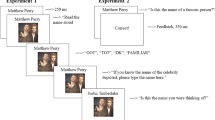Abstract
In this normative study, we investigated famous people recognition through personal name, using as stimuli the names of the same 40 Italian famous persons whose faces and voices had been utilized for the normative study of the Famous People Recognition Battery. For each famous people, we assessed name familiarity, person identification (when the name had been considered as familiar), and false alarms. The investigation was carried out on 143 normal subjects who varied in age and education. Name familiarity and semantic scores were affected by educational level, whereas age influenced false alarms. A comparison between results obtained with names in this research and with faces and voices of the same famous people in our previous study showed that familiarity scores were higher for personal names than those for faces and voices, which obtained the worst scores. Person identification scores were not significantly different from names and from faces, but both these scores were significantly higher than the semantic scores obtained by voices. Taken together, these results are inconsistent with the influential interactive activation and competition model of person recognition.
Similar content being viewed by others
References
Gainotti G, Marra C (2011) Differential contribution of right and left temporo-occipital and anterior temporal lesions to face recognition disorders. Front Hum Neurosci 5:55. https://doi.org/10.3389/fnhum.2011.00055
Gainotti G (2011) What the study of voice recognition in normal subjects and brain-damaged patients tells us about models of familiar people recognition. Neuropsychologia 49(9):2273–2282. https://doi.org/10.1016/j.neuropsychologia.2011.04.027
Gainotti G (2013) Neuropsychologia 51(7):1151–1160. Laterality effects in normal subjects’ recognition of familiar faces, voices and names. Perceptual and representational components. https://doi.org/10.1016/j.neuropsychologia.2013.03.009
Hanley JR (2014) Front Biosci (Elite Ed) 6:198–207. Accessing stored knowledge of familiar people from faces, names and voices: a review
Haslam C, Kay J, Hanley JR, Lyons F (2004) Biographical knowledge: modality specific or modality-neutral? Cortex 40(3):451–466. https://doi.org/10.1016/S0010-9452(08)70139-4
Hanley JR, Smith T, Hadfield J (1998) I recognise you but I can’t place you: an investigation of familiar-only experiences during tests of voice and face recognition. Q J Exp Psychol 51A:179–195
Hanley JR, Damjanovic L (2009) It is more difficult to retrieve a familiar person’s name and occupation from their voice than from their blurred face. Memory 17(8):830–839. https://doi.org/10.1080/09658210903264175
Rizzo S, Venneri A, Papagno C (2002) Famous face recognition and naming test: a normative study. Neurol Sci 23:153–159
Bizzozero I, Lucchelli F, Pozzoli S, Saetti MC, Spinnler H (2007) Neurol Sci 28(1):16–30. What do you know about Ho Chi Minh? Italian norms of proper name comprehension. https://doi.org/10.1007/s10072-007-0743-y
Quaranta D, Piccininni C, Carlesimo GA, Luzzi S, Marra C, Papagno C, Trojano L, Gainotti G (2016) Neurol Sci 37(3):345–352. Recognition disorders for famous faces and voices: a review of the literature and normative data of a new test battery. https://doi.org/10.1007/s10072-015-2437-1
Burton AM, Bruce V, Johnston RA (1990) Understanding face recognition with an interactive activation model. Br J Psychol 81(3):361–381. https://doi.org/10.1111/j.2044-8295.1990.tb02367.x
Burton AM, Bruce V, Hancock PJB (1999) From pixels to people: a model of familiar face recognition. Cogn Sci 23(1):1–31. https://doi.org/10.1207/s15516709cog2301_1
Gainotti G (2015) Implications of recent findings for current cognitive models of familiar people recognition. Neuropsychologia 77:279–287. https://doi.org/10.1016/j.neuropsychologia.2015.09.002
Spinnler H, Tognoni G (1987) Standardizzazione e taratura di test neuropsicologici. Ital J Neurol Sci 8:1–120
Orsini A, Grossi D, Capitani E, Laiacona M, Papagno C, Vallar G (1987) Verbal and spatial immediate memory span: normative data from 1355 adults and 1112 children. Ital J Neurol Sci 8(6):539–548
Jacoby LL, Rhodes MG (2006) False remembering in the aged. Curr Dir Psychol Sci 15(2):49–53. https://doi.org/10.1111/j.0963-7214.2006.00405.x
Gras D, Tardieu H, Piolino P, Nicolas S (2011) Presentation modality effect on false memories in younger and older adults: the use of an inference paradigm. Memory 19(1):92–102. https://doi.org/10.1080/09658211.2010.537278
Moyse E (2014) Age estimation from face and voice. A review. Psychol Belg 5:255–265
Luzzi S, Coccia M, Polonara G, Reverberi C, Ceravolo G, Silvestrini M, Fringuelli F, Baldinelli S, Provinciali L, Gainotti G (2017) Selective associative phonagnosia after right anterior temporal stroke. Neuropsychologia. https://doi.org/10.1016/j.neuropsychologia.2017.05.016
Papagno C, Mattavelli G, Casarotti A, Riva M, Bello L, Gainotti G (2017) Defective recognition and naming of famous people from voice in patients with unilateral temporal lobe tumors. Neuropsychologia. https://doi.org/10.1016/j.neuropsychologia.2017.07.021
Luzzi S, Baldinelli S, Ranaldi V, Fabi K, Cafazzo V, Fringuelli F, Silvestrini M, Provinciali L, Reverberi C, Gainotti G (2017) Neuropsychologia 94:118–128. Famous faces and voices: differential profiles in early right and left semantic dementia and in Alzheimer’s disease. https://doi.org/10.1016/j.neuropsychologia.2016.11.020
Author information
Authors and Affiliations
Corresponding author
Ethics declarations
The present study involved research on healthy subjects who provided their informed consent to participate.
Conflict of interest
The authors declare that they have no conflict of interest.
Rights and permissions
About this article
Cite this article
Piccininni, C., Quaranta, D., Papagno, C. et al. Famous people recognition through personal name: a normative study. Neurol Sci 39, 663–669 (2018). https://doi.org/10.1007/s10072-018-3251-3
Received:
Accepted:
Published:
Issue Date:
DOI: https://doi.org/10.1007/s10072-018-3251-3



